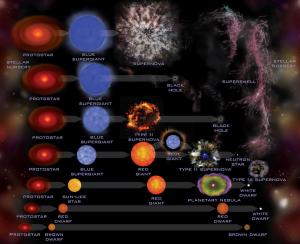Blog
Destiny
11 November 2013
 NASA/CXC/M.Weiss
NASA/CXC/M.WeissThe evolution of a star depends mainly upon its mass. There are other factors such as metallicity that can affect a star’s evolution, but the main factor is mass. It is the mass of a star that determines its destiny. You can see these various destinies in the figure above.
Although our Sun is often portrayed as a relatively small star, it is more massive than about 90% of the stars in our galaxy. A sun-like star fuses hydrogen in its core for about 10 billion years, before becoming a red giant. It then settles down to a white dwarf star. White dwarfs that have close binary stars can capture matter from its companion to become a supernova, but our Sun will not take that path.
The vast majority of stars (about 76%) are red dwarf stars. They fuse hydrogen slowly and for a long time. The smaller of these can fuse hydrogen for more than a trillion years before becoming a white dwarf.
Stars larger than our Sun live brighter, shorter lives. The largest fuse elements for only about 10 million years before they end as a supernova, or even hypernova. The cores of some of these become black holes, but their outer layers are strewn out into the universe where material from lots of supernovae eventually collapse into stellar nurseries.
Since the evolution of a particular star depends upon its mass, the evolution of a galaxy or star cluster depends upon the mass distribution of the first stars formed in a galaxy or cluster. This is known as the initial mass function. In yesterday’s post I wrote about how meteroids have a power-law size distribution. For example, you might have twenty 10-meter meteoroids for every 100-meter one, and four hundred 1-meter ones. Stellar masses also follow a power-law size distribution.
It has traditionally been thought that the initial mass function for galaxies is about the same for all galaxies. In astronomer-speak, we typically say the initial mass function is universal. But a paper in Nature last year1 showed that there is some variation between galaxies. It seems the interaction between regular matter and dark matter makes the initial mass function critically dependent on a galaxy’s formation history.
So it seems the destiny of a star also depends upon the history of its home galaxy.
Cappellari, Michele, et al. “Systematic variation of the stellar initial mass function in early-type galaxies.” Nature 484.7395 (2012): 485. ↩︎